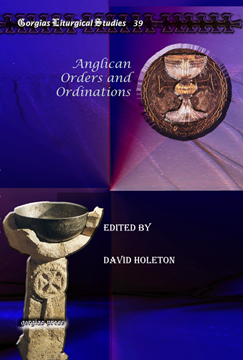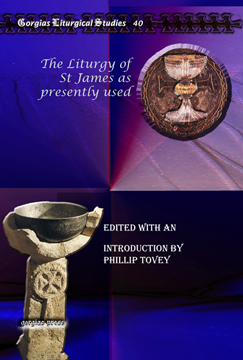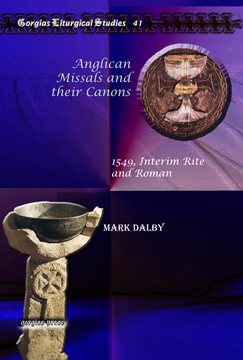Anglican Orders and Ordinations
Edited by David Holeton
Series: Kiraz Liturgical Studies 39
ISBN: 978-1-60724-390-8
Essays and Reports from the Interim Conference at Jarvenpaa, Finland, of the International Anglican Liturgical Consultation, 4-9 August 1997.
$138.00 (USD) $82.80 (USD)
The Liturgy of St James as presently used
Edited with an Introduction by Phillip Tovey
Series: Kiraz Liturgical Studies 40
ISBN: 978-1-60724-391-5
The Liturgy of St James is used by a number of churches. This gives the Greek, Syriac and Reformed (Mar Thoma Syrian Church) texts in parallel columns for comparison.
$138.00 (USD) $82.80 (USD)
Anglican Missals and their Canons
1549, Interim Rite and Roman
By Mark Dalby
Series: Kiraz Liturgical Studies 41
ISBN: 978-1-60724-392-2
With the 1552 prayer book the weaponry of the earlier liturgical works changed. This booklet discusses the missals and canons up to the modern period.
$138.00 (USD) $82.80 (USD)
Baptism in Early Byzantine Palestine 325-451
By Juliette Day
Series: Kiraz Liturgical Studies 42
ISBN: 978-1-60724-393-9
Juliette Day read a fascinating paper on this subject at the SLS Conference in 1998, and has now turned it into a published Study. It is distinguished by her great care about issues of both topography and dating in relation to Palestine, and in the process she both corrects other scholars and gives a notable overview of a special period.
$138.00 (USD) $82.80 (USD)
Ambrosianum Mysterium
The Church of Milan and its liturgical tradtion
By Cesare Alzati; Translated by George Guiver & C.R.
Series: Kiraz Liturgical Studies 43
ISBN: 978-1-60724-394-6
The author is the Milanese expert on the Ambrosian rite and this (with Volume 2) makes available in English very important material previously unknown.
$138.00 (USD) $82.80 (USD)
Mar Nestorius and Mar Theodore The Interpreter
The Forgotten Eucharistic Prayers of East Syria
Translated and Annotated by Bryan Spinks
Series: Kiraz Liturgical Studies 44
ISBN: 978-1-60724-395-3
This is a brilliant addition to the comprehensive range of patristic liturgical materials offered by this Series.
$138.00 (USD) $82.80 (USD)
The Eucharistic Doctrine of The Later Nonjurors
A Revisionist View of the 18th-Century Usages Controversy
By James Smith
Series: Kiraz Liturgical Studies 45
ISBN: 978-1-60724-396-0
The division between the 'Usagers' and the 'Non-Usagers' is fairly well known, but is here clarified and charted in detail but within a view of the overall non-juring situation.
$138.00 (USD) $82.80 (USD)
The Syriac Version of the Liturgy of St James
A brief history for Students
Series: Kiraz Liturgical Studies 47
ISBN: 978-1-60724-398-4
This is a Study which will open windows galore for Westerners, for not only is the history as recorded likely to cover ground untrodden by most English-speaking liturgists, but equally the surrounding field of study and its other scholarly occupants (who are laid heavily under contribution) will also be largely unknown.
$138.00 (USD) $82.80 (USD)
Offerings from Kenya to Anglicanism
Liturgical Texts and Contexts including 'A Kenyan Service of Holy Communion'
By Graham Kings & Geoff Morgan
Series: Kiraz Liturgical Studies 48
ISBN: 978-1-60724-399-1
The 1989 Kenyan eucharistic text has had much publicity, including its use at the opening service of the 1998 Lambeth Conference, but has had little in the way of introduction or commentary. These two authors, with much Kenyan experience and with encouragement from the key persons in Kenya, here provide the text with a valuable contextual exposition.
$138.00 (USD) $82.80 (USD)
Early Jewish Liturgy
A Sourcebook for use by students of Early Christian Liturgy
Series: Kiraz Liturgical Studies 49
ISBN: 978-1-60724-400-4
Whereas many studies suggest or presuppose some link between Christian liturgical origins and the practices of Judaism the Jewish sources are hard to find and understand for Christian students without any background in early Judaism and its literature. This book presents some of the relevant sources in clear English, with accompanying material which sets the sources in their context and introduces the student to the debate about the relationship between Jewish and early Christian liturgy.
$110.00 (USD) $66.00 (USD)









